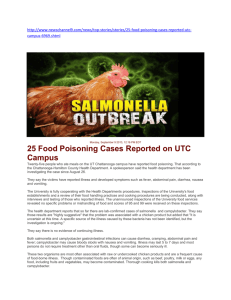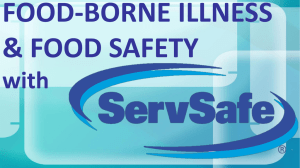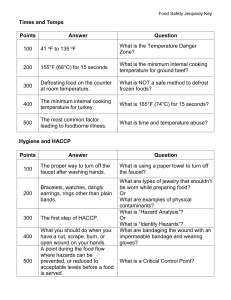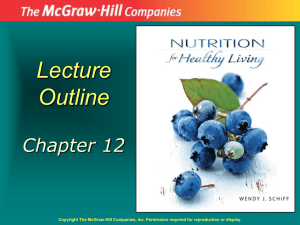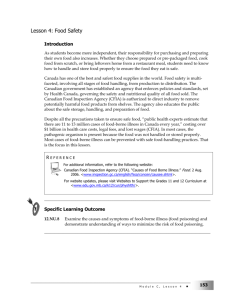Food Safety: Illnesses, Hazards, and Prevention Worksheet
advertisement
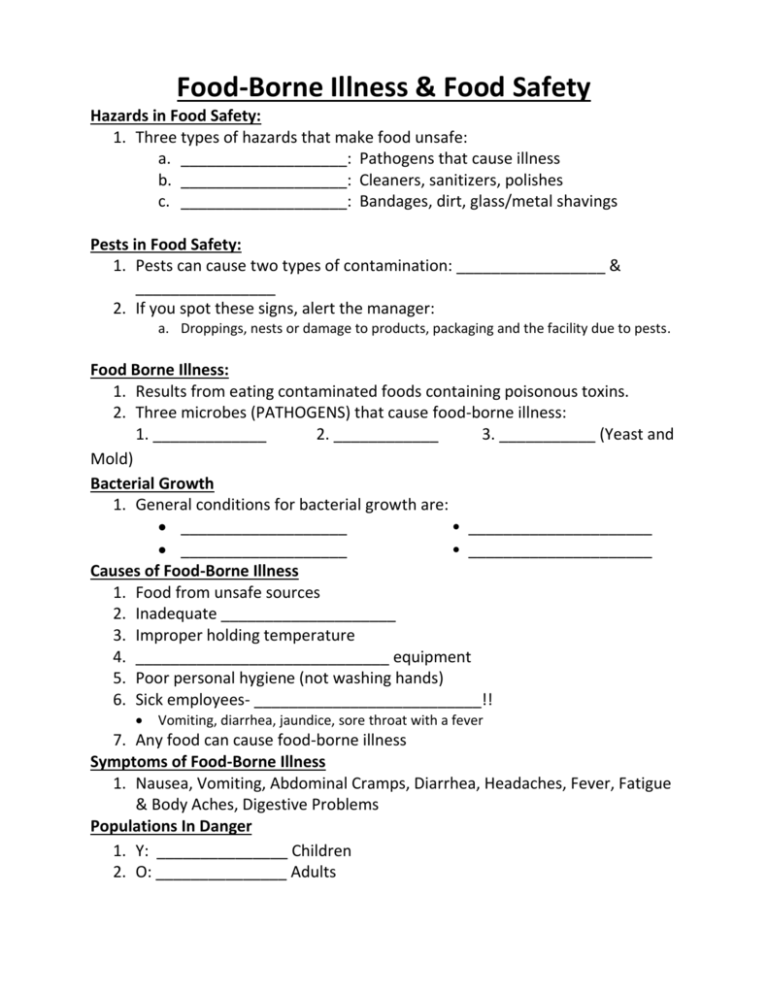
Food-Borne Illness & Food Safety Hazards in Food Safety: 1. Three types of hazards that make food unsafe: a. ___________________: Pathogens that cause illness b. ___________________: Cleaners, sanitizers, polishes c. ___________________: Bandages, dirt, glass/metal shavings Pests in Food Safety: 1. Pests can cause two types of contamination: _________________ & ________________ 2. If you spot these signs, alert the manager: a. Droppings, nests or damage to products, packaging and the facility due to pests. Food Borne Illness: 1. Results from eating contaminated foods containing poisonous toxins. 2. Three microbes (PATHOGENS) that cause food-borne illness: 1. _____________ 2. ____________ 3. ___________ (Yeast and Mold) Bacterial Growth 1. General conditions for bacterial growth are: ___________________ • _____________________ ___________________ • _____________________ Causes of Food-Borne Illness 1. Food from unsafe sources 2. Inadequate ____________________ 3. Improper holding temperature 4. _____________________________ equipment 5. Poor personal hygiene (not washing hands) 6. Sick employees- __________________________!! Vomiting, diarrhea, jaundice, sore throat with a fever 7. Any food can cause food-borne illness Symptoms of Food-Borne Illness 1. Nausea, Vomiting, Abdominal Cramps, Diarrhea, Headaches, Fever, Fatigue & Body Aches, Digestive Problems Populations In Danger 1. Y: _______________ Children 2. O: _______________ Adults 3. P: _______________ Women 4. I: _______________-Compromised Types of Food Borne Illness Illness Most Common Source Prevention Improperly canned foods Don’t eat from bulging cans Fresh poultry and raw eggs Cook ground products completely Wash hands (with soap) for at least 20 seconds Cook poultry and egg products completely Human mucus Frequently clean work surfaces Undercooked ground beef Improper hand washing Infected food handler Time and temperature abuse Unpasteurized milk and contaminated water Wash hands and do not work when sick Keep food at proper temperatures Ensure liquids are safe and clean before using Preventing Food Borne Illness: 1. When in doubt…______________________! 2. Keep ___________ foods hot and _________________ foods cold. 3. Use proper hand washing techniques. 4. Keep foods out of the ________________________________________. 5. Cook, reheat and serve foods to the proper internal temperatures. 6. Avoid cross-contamination Avoiding Cross Contamination 1. Never place cooked food on a plate which has previously held raw meat, poultry or seafood. 2. Always _____________________, cutting boards and food prep surfaces with hot soapy water after they come in contact with raw meat, poultry or seafood. 3. If food becomes cross-contaminated, set the food ___________________ and ask the manager what to do. 4. Never scoop ice with your bare hands or a glass. Always use ______________________ to get ice. 5. Do ____________ hold utensils by the part that comes into contact with food. 6. Use tongs, gloves or deli-sheets to serve ready-to-eat foods like bagels. 7. Change gloves after handling raw meat, poultry and seafood. 8. ______________________________ after they get dirty or torn. 9. Wear ____________________ over wounds and use a water-proof finger cover over bandages and under __________________. Allergens 1. Proteins that cause allergic reactions are called ____________________. 2. Cross-________________ is when one food allergen comes into contact with another food item and their proteins mix. 3. The BIG 8 refer to the allergens that cause the _____________________________: Milk, Soy, Eggs, Fish, Tree Nuts, Peanuts, Crustaceans Shellfish and Wheat. Temperature Controls for Safety (TCS) 4. Some foods have a greater risk for microbe (____________________) growth. 5. The best way to control this growth is to control the factors of ____________________. 6. Foods Most At Risk: • Milk/Dairy • Shellfish • Beans • Meat • Baked Potatoes • Vegetables • Fish • Tofu • Sliced Melons • Eggs • Sprouts • Tomatoes • Poultry • Cooked Rice • Lettuce Temperature Danger Zone (TDZ) 1. Any temperature between _______°F and ________°F. Cold foods should be kept lower than 41°F and hot foods should be kept higher than 135°F. 2. Foods should not be in the TDZ for more than ________ hours. 3. Foods in the TDZ for more than 4 hours should be __________________. 4. ____________________________________ (TCS) abuse is allowing food to stay in the danger zone. Important Temperatures: 1. Always check the ________________ temperature of foods with a food thermometer. Always check the __________________ part of the food. Seafood, beef, veal, lamb & pork Ground Meats Poultry Reheating Foods (Leftovers) ____________°F ____________°F ____________°F ____________°F Food Storage: 1. Refrigerators should be _______°F or below. 2. Freezers should be _____°F below. 3. Separate food into ____________________ containers to cool more rapidly. 4. ________________________ food properly. Thawing Foods Safely: 1. In the ________________________ for 2-3 days. This is the safest method. 2. Under ____________, running water. 3. In the __________________ if used immediately. 4. As part of the ____________________ process 5. __________________ defrost frozen food at room temperature.



